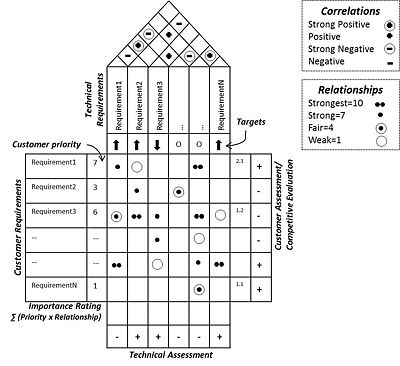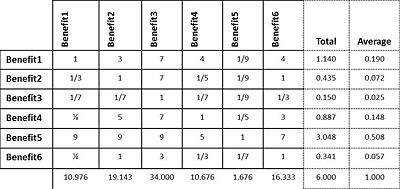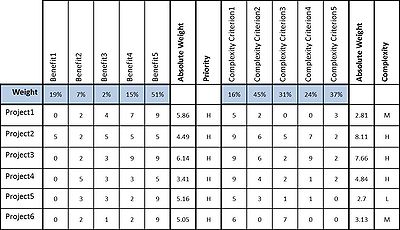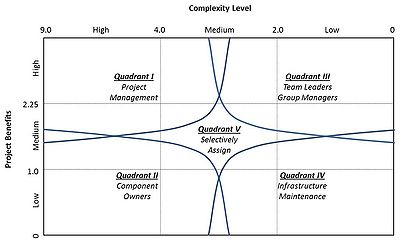Project Prioritization in Portfolio Management using Quality Function Deployment
Developed by Stamatia Chatzilazarou
The changes within the internal and external environment require from companies to choose the projects that will create economic value and benefit the whole organisation. To manage effectively new and pending projects in the portfolio, prioritization is essential in terms of executing first the projects that will benefit more the company while they are always aligned with the business strategy. Prioritizing and separating high priority from low priority projects could be a challenging process considering that company’s available resources (financial, human or physical) should be managed in the optimal way.
Quality Function Deployment (QFD) is a systems design method which focuses on the needs of the client. It assists the development team during the design stage of a system, a process, a product or a service, by translating the requirements set by the customer into engineering specifications. QFD is a recognized power tool and its use has been expanded into other disciplines as well. For instance, there are many examples in literature, where QFD is applied in construction project management for identifying customer requirements during the design phase. Moreover, QFD is used to support strategic as well as operational decisions within a company.
Using QFD to support the project prioritization in the portfolio of an organization is an interesting approach, however it has not been used extensively yet. This results in a limited literature regarding the adaptation of the traditional QFD method. The aim of this article is to examine thoroughly the use of the QFD method in project prioritization within a portfolio, providing a five-step described application suggestion, which will also ensure the most efficient allocation of company’s human resources to each project.
Contents |
Background
Quality Function Deployment (QFD) is a structured process-oriented approach to product quality design which concentrated on customer’s requirements and expectations. Although it is mainly used during the design stage, QFD can assist the whole system development process, as can be used in defining marketing strategies, planning, product design and engineering, prototype evaluation, development of production processes, production and sales [1].
QFD has its origins in Japan, where it was developed in mid-1960s by Dr. Yoji Akao, under the umbrella of Total Quality Management (TQM) to support product quality design[2]. It was not before mid-1980s when the technique was appreciated, became popular and started being applied extensively by companies in the Western world [3]. The transformation of customer’s requirements into design and quality assurance targets, which were used later during the production stage, assured that the final product would meet the expectations of both the customer and the final user [4].
Apart from aiming on the satisfaction of customer’s requirements, QFD is a valuable tool which can support the design team, as it ensures a good and convenient communication between them and the client. In addition, the successful use of QFD can promote the possibility of trade-offs between what the customer needs and what engineering characteristics are affordable for the company to develop [5]. Moreover, by targeting on meeting customer’s needs, the re-design or product/process modification time is decreased, which subsequently leads to cost reduction. As has been noticed, the right implementation of QFD in a company can reduce engineering changes by 30-50%, design cycles by 30-50%, start-up costs by 20-60% and warranty by 20-50% [4].However, QFD is not a method that can be applied easily. The application of QFD is based on the development of a series of interrelated matrices, which is a complex and time-consuming process. The most widely used matrix is the ‘House of Quality’, a matrix that enables the prioritization of the engineering characteristics by prioritizing customer’s needs. . A widely accepted approach to QFD and ‘House of Quality’ has been established by the American Supplier Institute (ASI) and can be summarized in the following four phases[1]:
- Phase 1
- Customer requirements, expressed in a qualitative way, are prioritized and translated into quantitative features of the product (technical requirements), which can be measured and are design-independent.
- Phase 2
- The relationships between the quality requirements and the different design parts are identified, having as a final outcome the prioritization of the design parts that fulfill the quality goals set by the client. Moreover, the correlations between the quantitative technical features are defined to diagnose which of them are in conflict with each other.
- Phase 3
- Manufacturing processes and specification of crucial process parameters, which will deliver great value to the customer, are prioritized.
- Phase 4
- The most important manufacturing processes (identified in Phase 3) are translated into an action plan, comprised with specific work instructions and possible training demands, the implementation of which will ensure that the required level of quality in the production is retained.
QFD correlation matrices can be also used for ranking competitors’ products by means of technical and customer benchmarking[5]. Information about the customer requirements that need to be satisfied can be gathered by the marketing department through surveys, interviews, trade shows and journals, customer complaints, etc.[1].
It is essential that QFD is implemented in the initial stages of product or service development to assure that all the design changes are done before production has started and before prototyping [4]. The further analysis of the QFD results can be the basis of other tools and methodologies used during the design phase, such as Failure Mode and Effects Analysis (FMEA) or Cost-Worth Analysis (CWA)[6].
Other Applications
Although when developed, QFD was a method used in product design, nowadays there are many extensions and adaptations of QFD which make it an important management technique applicable in various fields and functions within a company for optimization of internal processes. Since QFD is a popular and powerful method, it has been applied in all different types of industries, from automobiles and electronics manufacturers, to government, healthcare, research and even education. For instance, apart from defining customer needs, QFD has been used in organisations for, developing priorities[7], formulating annual policies[8] and manufacturing strategies[9] [10], and environmental decision-making [11]. The table below indicates some of the application areas of QFD and where they can be found in literature[1].
| Application areas of QFD | |
|---|---|
| Application area | Authors |
| Performance | Ellis (1998), Jagdev et al. (1997), Kochhar & Eguia (1998), Kochhar & Saeed (1999), Kutucuoglu et al. (2001), Lim et al. (1999), Roche & Jackson (1994) |
| Processes | Jacobs et al. (1995), Mrad (1997, 1999), Partovi (2007) |
| Quality of services | Van Looy et al. (1998) |
| Optimal design requirements | Park and Kim (1998) |
| Equipment | Hales (1995) |
| Facility locations | Chuang (2001) |
| Marketing strategies | Nagendra & Osborne (2000) |
| Optimal instrumentation | Doyotte et al. (1999) |
| R&D projects | Curtis & Ellis (1998) |
| Service delivery priorities | Curry (1999) |
| System reliability | Verma & Knezevic (1996) |
| Measuring customer satisfaction | Motwani et al. (1996) |
| Quality improvement in engineering department | Owlia & Aspinwall (1998) |
| ERP selection | Karsak and Ozogul (2007) |
| Software development | Barnett and Raja (1995) |
| Higher education curriculum | Bier and Cornesky (2001) |
| Customer driven healthcare | Chaplin and Terninko (2000) |
Since QFD is a popular and powerful method, it has been applied in all different types of industries, from automobiles and electronics manufacturers to government, healthcare, research and even education. Many combinations with other approaches or methods, and adaptations have been developed in order to make the application of QFD more efficient within different fields. Some of these combinations is the fuzzy QFD, where the fuzzy set theory is incorporated into QFD, dynamic QFD, where dynamic programming is combined with QFD, and integration of analytical hierarchy process (AHP), a multi-criteria decision-making method, into QFD. Combinations of QFD with AHP were used for assisting project selection[12], robot selection[13], rapid tooling process selection[14], improvement of education quality in academic institutions[15] or identification of suitable teaching techniques[16].
Another field where QFD has started to be applied successfully and more extensively is the construction industry. Implementing QFD during a construction project has proven to accelerate the design process, as the identification of the client’s requirements saves time of possible future re-designs. This results in an easier decision-making process in the next phases of the project[17].
Application in Portfolio Management
An interesting but at the same time challenging implementation of QFD in Portfolio Management is to support the prioritization of a company’s existing projects, and later on the assignment of each project to the most relevant persons. Without being structured and standardized across the different departments of a company, the prioritization of the projects can be an effortful and inefficient process. The challenges that occur during the prioritization are usually a result of the different individual priorities of the company’s internal stakeholders related to each project.
Managers tend to assign key and skillful employees to projects without considering employees’ current work overload. Consequently, employees have to prioritize on their own the projects that they are responsible for. As has been noticed, employees are more likely to set as a high priority projects that are more beneficial for them than the company. In other words, employees prefer working on a project that will enhance their personal skills rather than working on a project that will create value for their department and subsequently for the company as a whole.
This fact shows how essential a structured prioritization process is for a company, as it provides the managers with the ability to ensure that the projects that are defined as of high priority are these that actually add value to the company. At the same time it helps employees, who are able to be focused on the execution of the most beneficial for the company tasks, without losing time leaping from one project to another[18].
Implementation
The implementation of QFD in Portfolio Management for the prioritization of the projects can be described in five steps.
Step 1
Formation of group of internal stakeholders
To begin with, it is necessary the formation of a group of the internal customers of the company. This group includes people that are involved in the various projects and initiatives that need to be executed. For instance, this group is composed of managers from the departments of the company, project team leaders, technical staff and representatives of any possible group within the company that have any influence on the projects.
This group is formed in order to be in charge of the portfolio. That includes the prioritization of the projects, the reporting of the status for each project, as well as, activities as managing the available resources and deciding which projects should be canceled or postponed, when other projects more beneficial and with higher significance are in contention with strategic resources[18].
Step 2
Determination and prioritization of project benefits
Once the internal stakeholder-group is formed, it has to gather all the projects to be executed and afterwards define all the benefits that these projects will bring both to internal and external customers of the company when they will be completed.
Following the determination of these benefits, the AHP method is applied in order to prioritize them. The benefits that the execution of the company’s projects will bring to the company do not have the same value and do not affect the company in the same way. For that reason, it is necessary to rank them and be aware of the benefits that are considered to be these with the higher level of importance and gravity for the company, according to the internal stakeholders group[18].
To rank the benefits using AHP, a prioritization matrix should be developed. The benefits are listed in the matrix and they are compared two at a time with the use of a verbal scale that is presented below[19]:
| AHP - Verbal scale | |
|---|---|
| Preference Level | Numeric Value |
| Equally important | 1 |
| Equally to moderately more important | 2 |
| Moderately more important | 3 |
| Moderately to strongly more important | 4 |
| Strongly more important | 5 |
| Strongly to very strongly more important | 6 |
| Very strongly more important | 7 |
| Very strongly to extremely strongly more important | 8 |
| Extremely more important | 9 |
The use of AHP makes easier the comparison of a pair of benefits, as first the group uses a natural language to compare the pair and afterwards this language is translated into an ordinal scale. Finally, these ratings are converted into numerical ratio scale priorities which indicate which benefit is most important and by how much[18].
Step 3
Determination and prioritization of complexity criteria and characteristics
In this step the complexity criteria need to be determined. These criteria usually have an impact on the completion of a project and determine the effectiveness of the person in charge. An example of these criteria could be the existing technology in the internal or external environment of the company. After establishing these criteria, the AHP method is used again in order to prioritize them and detect those that constitute the main challenges for the successful execution of the projects. The ranking of the complexity criteria is developed again through a prioritization matrix in the same way as Step 2[18]. The verbal scale that is used in this step is presented below[19]:
| AHP - Verbal scale | |
|---|---|
| Preference Level | Numeric Value |
| Equally complex | 1 |
| Equally to moderately more complex | 2 |
| Moderately more complex | 3 |
| Moderately to strongly more complex | 4 |
| Strongly more complex | 5 |
| Strongly to very strongly more complex | 6 |
| Very strongly more complex | 7 |
| Very strongly to extremely strongly more complex | 8 |
| Extremely more complex | 9 |
The determination and prioritization of the complexity criteria will help later to choose the right person that will be in charge during the life cycle of a project.
Step 4
Development of adapted ‘House of Quality’ matrix and project prioritization
To create the matrix that prioritizes the projects within the project portfolio, with respect to the benefits that add value to the company and with respect to the complexity criteria that challenge the successful execution of the projects, an adapted ‘House of Quality’ is developed.
In the rows of the matrix a list of company’s projects is entered while in the columns a list of the benefits and the complexity criteria determined in steps 2 and 3 respectively. Next, the relationship between each project and each benefit and criterion is rated using a 9-point scale. Multiplying the rating of each benefit with each benefit weight, calculated in Step 2, and adding all the results for each project, occurs a number which represents the absolute weight for each project. Likewise if the products of each criterion ratings and each criterion weight, calculated in Steps 3, are aggregated for each project, the number that occurs represents the absolute weight for each project respecting complexity. These are the numbers that indicate the priority of each project in the project portfolio, regarding the benefits and the complexity respectively. According to these calculated weights a project is classified as of Low, Medium or High priority and complexity[18].
Step 5
Development of Benefits vs. Complexity matrix allocation of projects to human resources
In the final step a ‘Benefits vs. Complexity’ matrix is developed in order to allocate the projects to the most relevant employees within the company, taking into consideration the level of significance and complexity of each project. To create this matrix, the benefit and complexity weights, calculated in steps 2 and 3, are necessary. The Project Benefits and the Complexity Level are set on the horizontal and vertical axes of the matrix and the projects are located in the right place within the plane that is formed.
The matrix that has been developed is divided into 5 quadrants, and each of those indicates the right project owners. The following list specifies the five categories of project owners and their basic characteristics of each one[18]:
- Project Management
- Component Owners
- Team leaders/Group Managers
- Infrastructure Maintenance
- Selectively assigned
The projects that are assigned to the project management team are characterized of medium-high benefits and medium-high complexity. That means that are essential projects which need to be completed on-time and on-budget, thus the implementation of project management methodologies is of high significance.
The projects that belong to the second quadrant are characterized of low-medium benefits but medium-high complexity. Usually they are short-term projects that do not require project management knowledge, thus they are assigned to individuals with strong technical skills.
These projects are of medium-high benefits for the company but of medium-low complexity and usually are improvement efforts to support production processes. Therefore, these projects are allocated to team leaders or group managers, who need to function as project managers for their completion.
Projects of medium-low benefits and medium-low complexity are usually small infrastructure projects that are assigned to technical project coordinators. Due to the low significance and complexity levels of these projects, in many cases many small projects are assigned to one coordinator.
When the projects belong to this quadrant which is the boundary between the other four quadrants, the benefit and complexity levels of each project as well as the resource constraints, need to be examined carefully before assigned.
Future Steps
In order to retain a prioritized portfolio, it is necessary for the internal stakeholders group to schedule regular meetings, for instance every one or two weeks, and rank the new projects that have arisen respecting their benefits and its complexity level. This will lead to the identification of the projects with the highest priority and complexity, which the project management team will have to take care of, and the allocation of the rest of the projects to the appropriate staff.
Another important aspect regarding the rating of each project is the periodical reassessment and update of the benefits and the complexity criteria by the internal stakeholders group. Assuring that the benefits and the complexity criteria are aligned with the current goals and strategy of the company ensures that each moment the company is pursuing the execution of the right projects[18].
Implementation Difficulties & Drawbacks
As mentioned in the beginning of the article, QFD is not a simple method to apply. This is not only because of the structure of the method but because of the details that its implementation requires as well. In the case of the implementation of QFD in the project portfolio, difficulties may occur in the different steps described above.
The first difficulty may arise in the forming of the group of internal stakeholders of the company. If there is no balance between the number of the group members coming from each department of the company there is a high possibility that it will cause problems during the rating phase. This may happen because the representatives of a department will rate as more beneficial projects that its execution will affect positively their department. Moreover if there is lack of technical expertise between the group members, the complexity criteria and subsequently their rating might not be accurate.
Another important implementation drawback is the time that is required from the company to apply the QFD method. The identification of the benefits and the complexity criteria is a process that need to be thoroughly and always taking into consideration which are the overall goals of the company and if the identified data are aligned with the current strategy of the company. This implies that QFD is a time-consuming and consequently costly method.
References
- ↑ 1.0 1.1 1.2 1.3 Mehrjerdi, Y. Z. (2010) ‘Quality function deployment and its extensions’, International journal of Quality & Reliability Management, vol. 27, no. 6, pp. 616-640.
- ↑ Jiang, J. C., Shiu, M. L. & Tu, M. H. (2007) ‘Quality function deployment (QFD) technology designed for contract manufacturing’, The TQM Magazine, vol. 19, no. 4, pp. 291-307.
- ↑ Moultrie, J. & Crilly, N. (2009) Summary notes on Duality Function Deployment (QFD). University of Cambridge: Engineering Department.
- ↑ 4.0 4.1 4.2 Herrmann, A, Huber, F., Algesheime, R. & Tomczak, T. (2006) ‘An empirical study of quality function deployment on company performance’, International Journal of Quality & Reliability Management, vol.23, no. 4, pp 345-366.
- ↑ 5.0 5.1 Bouchereau, V. & Rowlands, H. (2000) ‘Methods and techniques to help quality function deployment (QFD)’, Benchmarking: An International Journal, vol. 7, no. 1, pp. 8-20.
- ↑ Chao, L. P. & Ishii, K. (2004) ‘Project quality function deployment’, International Journal of Quality & Reliability Management, vol.21, no. 9, pp 938-958.
- ↑ Han, C.H., Kim, J.K., Choi, S.H. & Kim, S.H. (1998), “Determination of information system development priority using quality function deployment”, Computers and Industrial Engineering, vol. 35, no 1/2, pp. 241-4.
- ↑ Philips, M., Sander, P. & Govers, C. (1994), “Policy formulation by use of QFD techniques: a case study”, International Journal of Quality & Reliability Management, Vol. 11 No. 5, pp. 46-58.
- ↑ Crowe, T.J. and Cheng, C.C. (1996), “Using quality function deployment in manufacturing strategic planning”, International Journal of Operations&Production Management, Vol. 16, No. 4, pp. 35-48.
- ↑ Jugulum, R. and Sefik, M. (1998), “Building a robust manufacturing strategy”, Computers and Industrial Engineering, Vol. 35 Nos 1/2, pp. 225-8.
- ↑ Berglund, R.L. (1993), “QFD: a critical tool for environmental decision making”, Transactions of the 1993 ASQC Quality Congress, Boston, MA, pp. 593-9.
- ↑ Partovi, F.Y. (1999), “A quality function deployment approach to strategic capital budgeting”, Engineering Economist, vol. 44, no. 3, pp. 239-60.
- ↑ Bhattacharya, A., Sarkar, B. & Mukherjee, S.K. (2005), “Integrating AHP with QFD for robot selection under requirement perspective”, International Journal of Production Research, vol. 43, no. 17, pp. 3671-85.
- ↑ Hanumaiah, N., Ravi, B. & Mukherjee, N.P. (2006), “Rapid hard tooling process selection using QFD-AHP methodology”, Journal of Manufacturing Technology Management, vol. 17, no. 3, pp. 332-50.
- ↑ Koksal, G. & Egitman, A. (1998), “Planning and design of industrial engineering education quality”, Computers and Industrial Engineering, vol. 35, no 3/4, pp. 639-42.
- ↑ Lam, K. & Zhao, X. (1998), “An application of quality function deployment to improve the quality of teaching”, International Journal of Quality & Reliability Management, vol. 15, no. 4, pp. 389-413.
- ↑ Dodd, A. M. (1997) Quality function deployment: A method for improving contract specifications in the US Corps of engineers. Master of Science in Civil Engineering dissertation, The Pennsylvania State University, Pennsylvania, USA.
- ↑ 18.0 18.1 18.2 18.3 18.4 18.5 18.6 18.7 LePrevost, J. & Mazur, G. (2003) ‘Quality Infrastructure Improvement: Using QFD to Manage Project Priorities and Project Management Resources’, Transactions from the fifteenth symposium on Quality Function Deployment, The 15th Symposium on QFD/ The 9th International Symposium on QFD – Orlando FL USA.
- ↑ 19.0 19.1 Taylor, B. W. III (2006) Introduction to Management Science, New Jersey: Prentice Hall.




